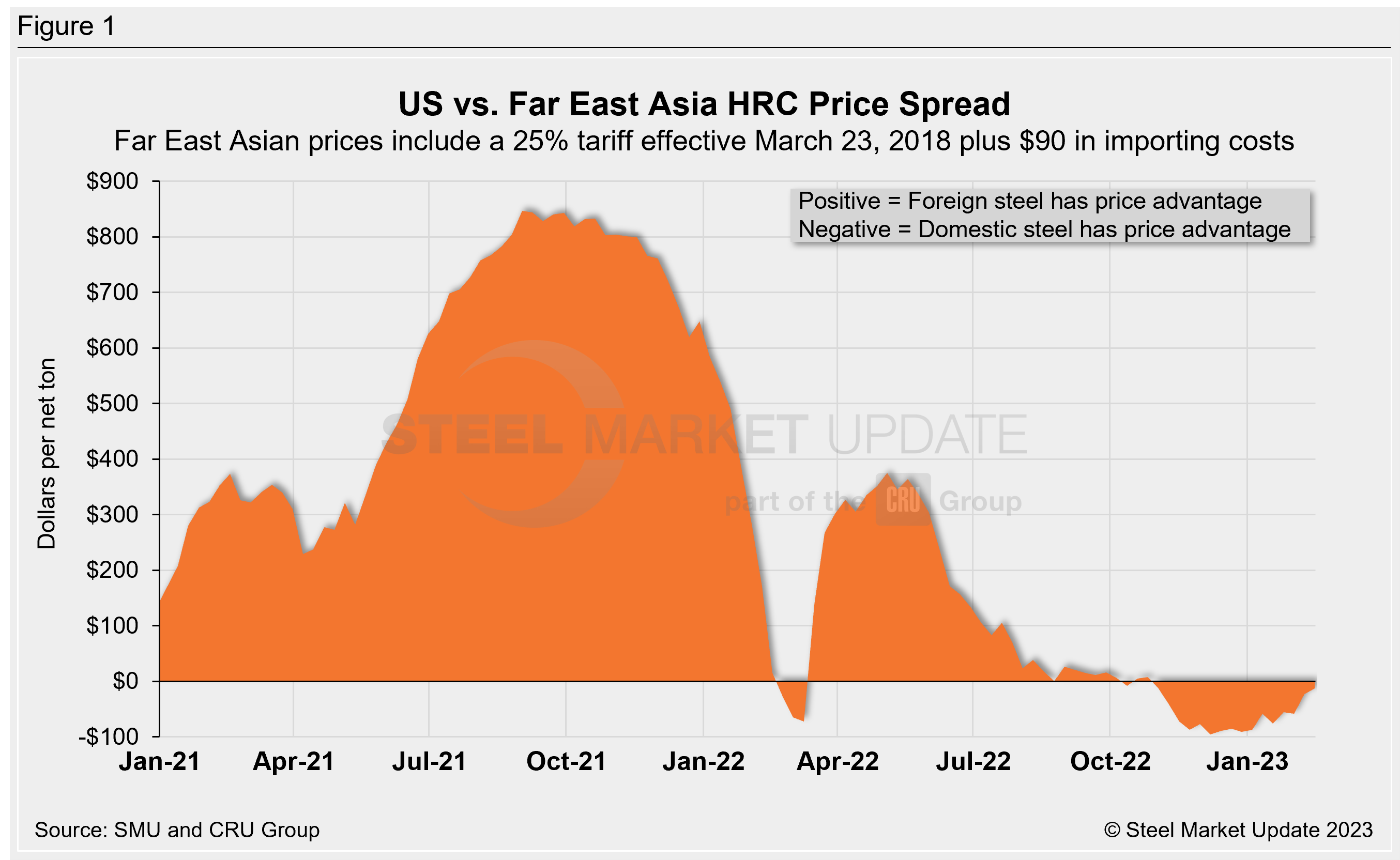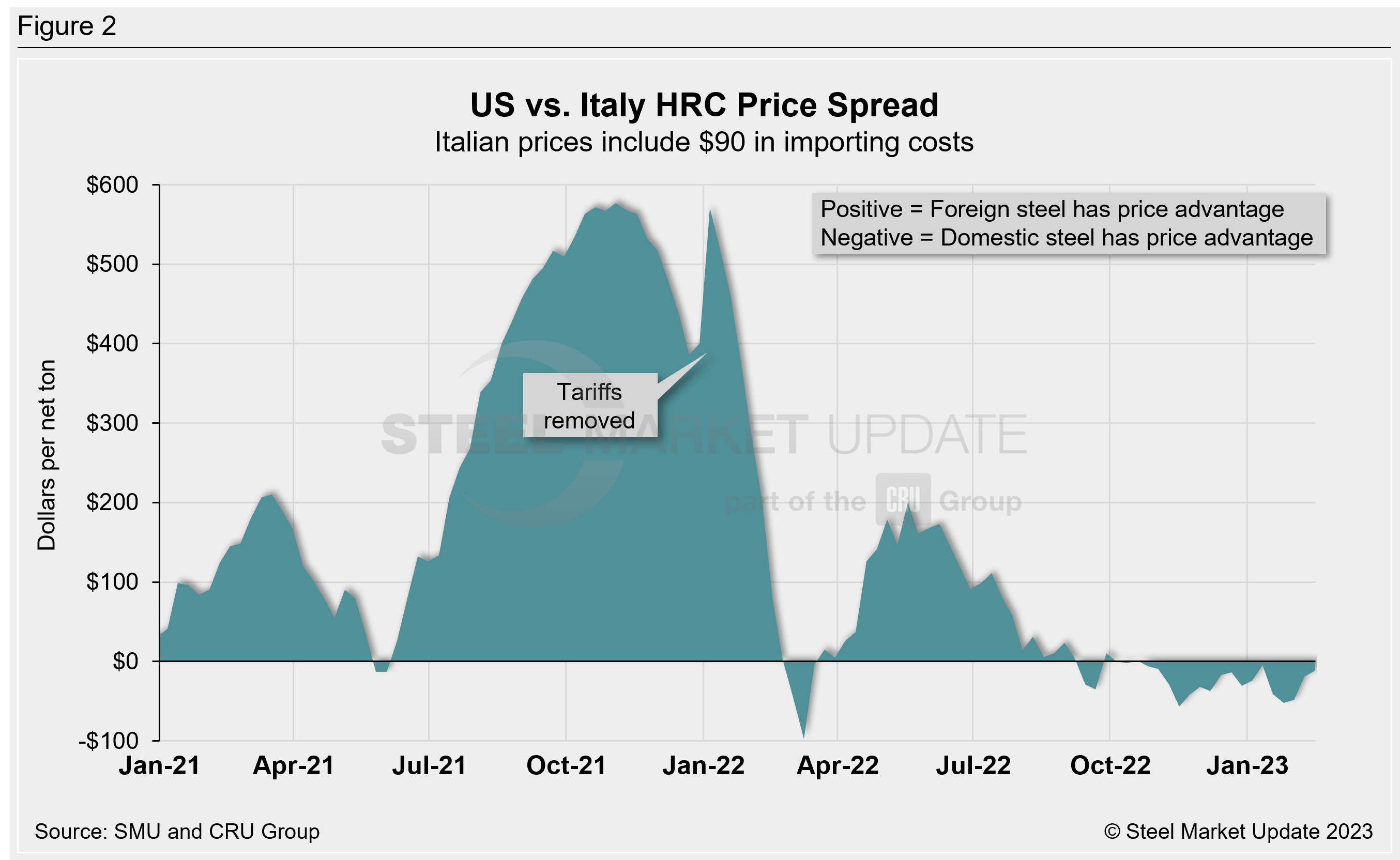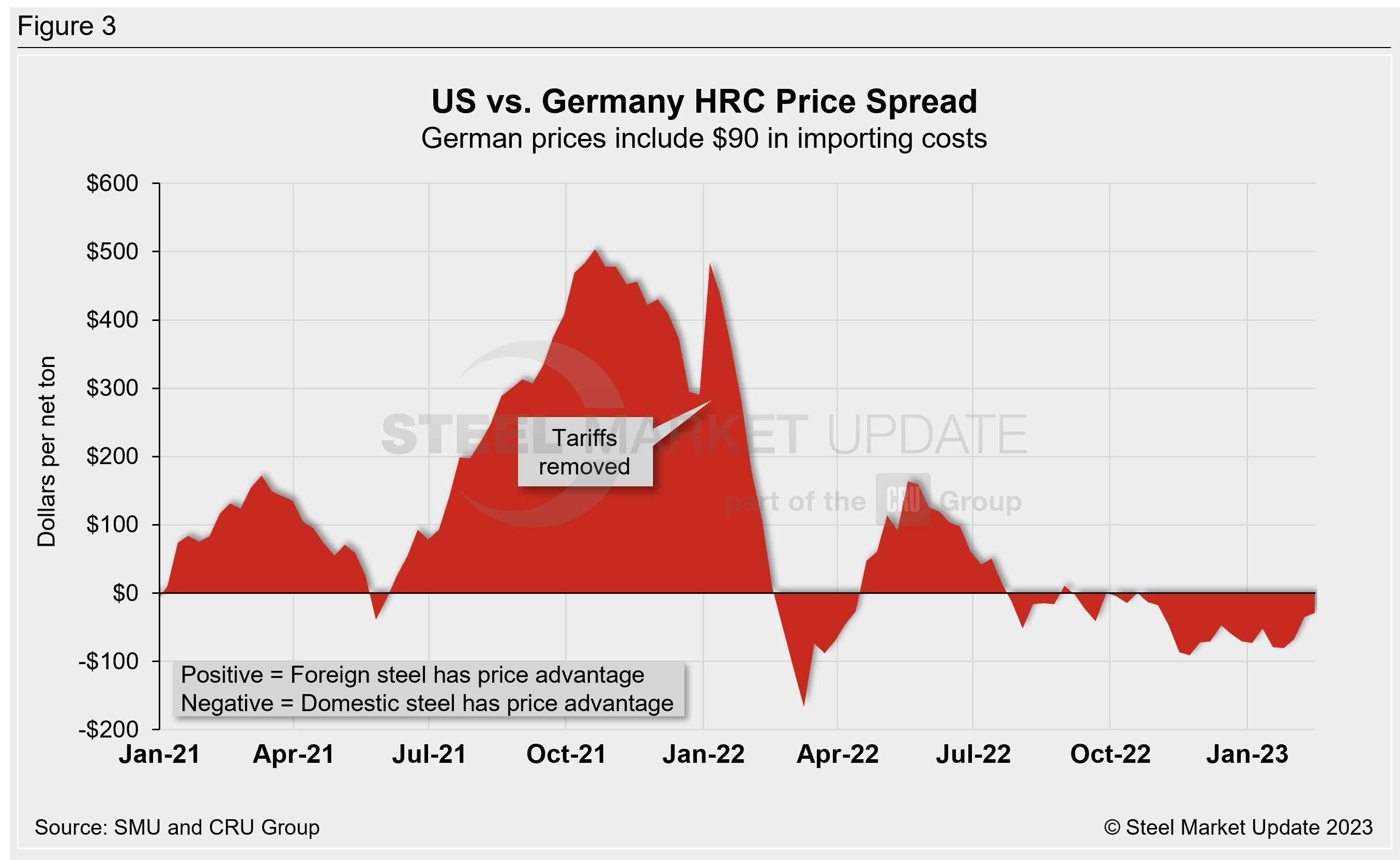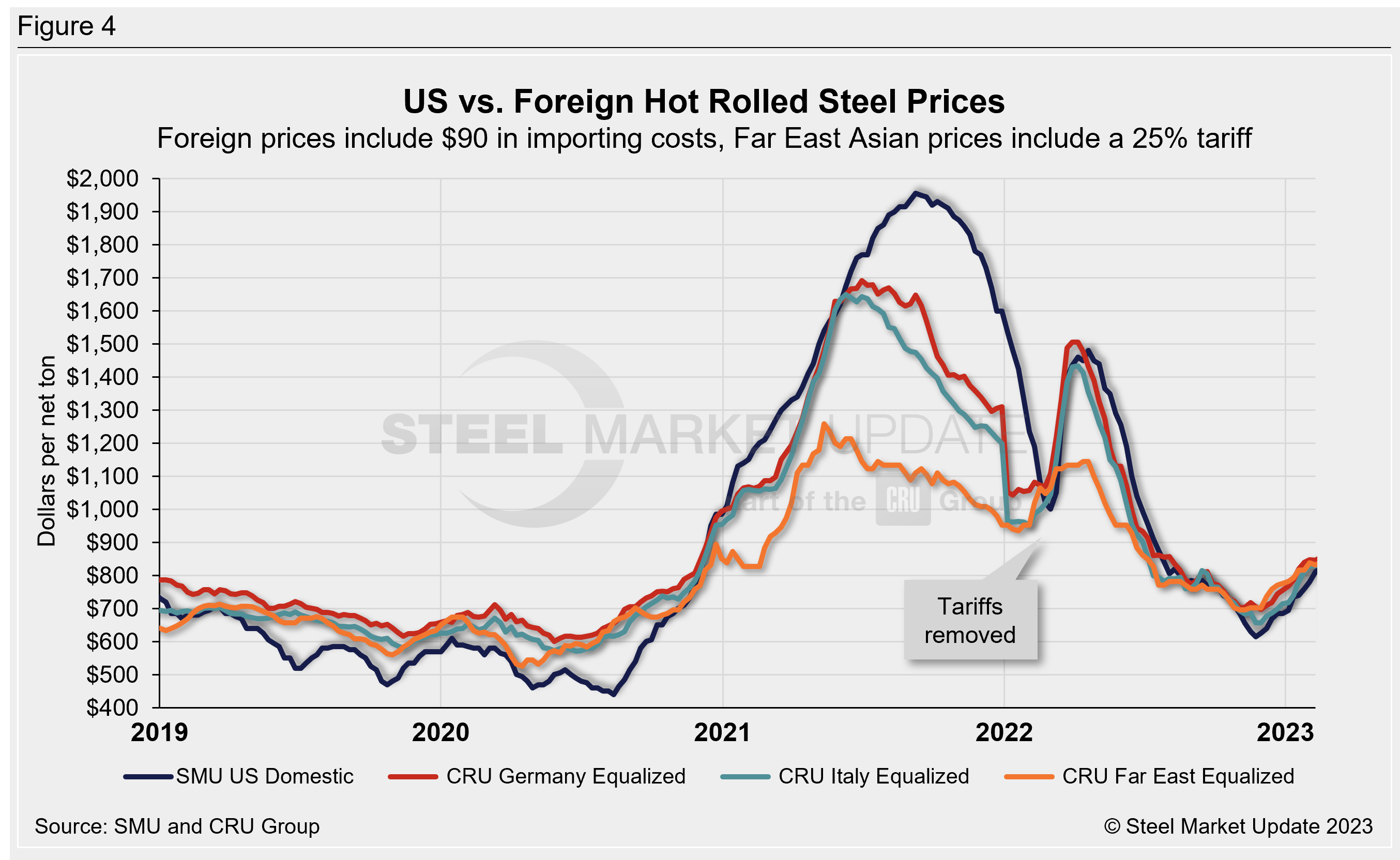Final Thoughts
Domestic HRC’s Competitive Advantage Over Imports Narrows
Written by David Schollaert
February 16, 2023
Domestic hot-rolled coil (HRC) kept its competitive price advantage over imported steel – now on a 16-week run. However, it has continued to lose momentum over the past four weeks, according to Steel Market Update’s latest foreign vs. domestic price analysis.
![]() US HRC is approximately 2.2% cheaper than foreign prices this week, down from 3.4% last week after consideration of freight costs, trader margins, and any applicable tariffs. US prices have been cheaper than foreign prices for all three regions we follow since the beginning of November. While margins have varied, HRC prices were up across all regions week on week (WoW).
US HRC is approximately 2.2% cheaper than foreign prices this week, down from 3.4% last week after consideration of freight costs, trader margins, and any applicable tariffs. US prices have been cheaper than foreign prices for all three regions we follow since the beginning of November. While margins have varied, HRC prices were up across all regions week on week (WoW).
The average spread slipped from $26 per ton last week to $18 per ton this week as US prices also moved up.
SMU uses the following calculation to identify the theoretical spread between foreign HRC prices (delivered to US ports) and domestic HRC prices (FOB domestic mills): Our analysis compares the SMU US HRC weekly index to the CRU HRC weekly indices for Germany, Italy, and Far East Asian ports. This is only a theoretical calculation because costs to import can vary greatly and often fluctuate, which influence the true market spread.
In consideration of freight costs, handling, and trader margin, we add $90 per ton to all foreign prices to provide an approximate CIF US ports price that can be compared against the SMU domestic HRC price. Buyers should use our $90-per-ton figure as a benchmark, adjusting it as necessary based on their own shipping and handling costs. If you have experience importing foreign steel and want to share your thoughts on these costs, we welcome your insight and comments: david@steelmarketupdate.com.
Far East Asian Hot-Rolled Coil (East and Southeast Ports)
As of Thursday, Feb. 16, the CRU Far East Asian HRC price increased by $5 per ton to $599 per net ton ($660 per metric ton), and was up $18 from levels one month prior. Adding a 25% tariff, and $90 per ton in estimated import costs, the delivered price of Far East Asian HRC to the US is $838 per ton. The latest SMU hot-rolled average is $825 per ton, up $15 per ton from our previous price update, and up $85 per ton compared to our price one month ago.
Therefore, US-produced HRC is now $13 per ton cheaper than steel imported from Far East Asia. This is down from a spread of $23 per ton one week prior. One month ago we saw a spread of $76 per ton, slipping from some of the largest price appeals that domestic HRC has had over Far East Asian HRC since September 2020.
Prior to October, Far East Asian prices had held the advantage since mid-March (the differential peaked at $375 per ton in May). The widest price advantage recorded for Far East Asian prices was nearly 16 months ago, at $847 per ton in September 2021.

Italian Hot-Rolled Coil
Italian HRC prices increased by $8 per ton WoW to $747 per net ton ($823 per metric ton) this week, and were $55 per ton higher month on month (MoM). After adding import costs, the delivered price of Italian HRC is approximately $837 per ton.
Domestic HRC is now theoretically just $12 per ton cheaper than imported Italian HRC, down from a spread of $19 per ton last week. One month ago we saw a spread of $41 per ton, favoring domestic prices. In mid-November we saw a spread of $57 per ton, the largest margin in favor of US prices recorded since last March.
Domestic steel has held this price advantage since late October. Before the removal of the 25% Section 232 tariff, the spread just 15 months ago reached $577 per ton in November, the largest in SMU’s data history.

German Hot-Rolled Coil
CRU’s latest German HRC price rose by $9 per ton WoW to $764 per net ton ($842 per metric ton), and was up $79 per ton MoM. After adding import costs, the delivered price of German HRC is roughly $854 per ton.
Accordingly, domestic HRC is now theoretically $29 per ton cheaper than imported German HRC, down from a spread of $35 per ton one week prior. Four weeks ago, prices between these regions were $79 per ton apart (with US prices holding the advantage). Domestic HRC has held this price advantage for all but three weeks since late July, on a 16-week run.
German HRC held the price advantage for the three months prior to that, having reached a 2022 high of $164 per ton in May. Before the removal of the 25% tariff, the October 2021 spread of $504 per ton was the widest in SMU’s data history.

Figure 4 compares all four price indices and highlights the effective date of the tariffs. Foreign prices are referred to as “equalized,” meaning they have been adjusted to include importing costs (and tariffs in some cases) for a like-for-like comparison against the US price.

Notes: Freight is an important part of the final determination on whether to import foreign steel or buy from a domestic mill supplier. Domestic prices are referenced as FOB the producing mill, while foreign prices are CIF the port (Houston, NOLA, Savannah, Los Angeles, Camden, etc.). Inland freight, from either a domestic mill or from the port, can dramatically impact the competitiveness of both domestic and foreign steel. When considering lead times, a buyer must take into consideration the momentum of pricing both domestically and in the world markets. In most circumstances, domestic steel will deliver faster than foreign steel ordered on the same day.
Effective Jan. 1, 2022, the traditional Section 232 tariff no longer applies to most imports from the European Union. it has been replaced by a tariff rate quota (TRQ). Therefore, the German and Italian price comparisons in this analysis no longer include a 25% tariff. SMU still includes the 25% Section 232 tariff on foreign prices from other countries. We do not include any antidumping (AD) or countervailing duties (CVD) in this analysis.
By David Schollaert, david@steelmarketupdate.com

David Schollaert
Read more from David SchollaertLatest in Final Thoughts

Final Thoughts
Despite some scary headlines lately (especially about Trump potentially firing Fed Chair Jerome Powell) this is not October 2008 (financial crisis) or March 2020 (onset of the pandemic). But it sure seems like we’ve taken a relatively strong economy and poured a thick sauce of uncertainty over it.

Final Thoughts
I put some of our survey data through ChatGpt, with interesting results.

Final Thoughts
Nearly 50% of respondents to our latest survey thought hot-rolled coil prices have already peaked. And where will those prices be two months from now? Responses were decidedly split on that question.

Final Thoughts
A modest week-to-week change in HR price understates a huge swing in expectations.

Final Thoughts
What happens when ChatGPT meets SMU's Market Chatter? No, this is not an idea for the latest Hollywood blockbuster. Then again, with what Hollywood is putting out these days, Chatter Meets Chat might just turn out to be a hit. Rather, it’s that old idea of putting theory into practice. Recently, I conducted an interview with Doug Schrock, managing principal of AI at public accounting and consulting firm Crowe. He gave some tips on how to implement AI into your business.
